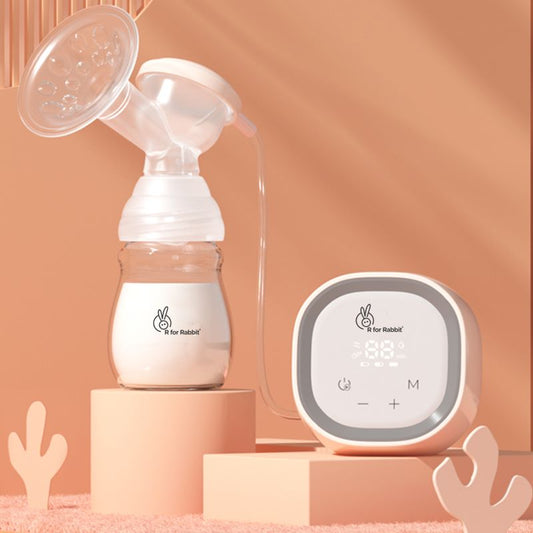How Effectively Mothers Can Use Manual Breast Pump?

Table of Contents
Quick Summary:
Being a mum is a rewarding yet challenging journey, and a manual breast pump can be your ultimate ally! Ideal for busy mothers, these portable and affordable pumps allow you to express milk anytime, anywhere. With customizable suction and easy-to-carry designs, manual breast pumps offer convenience without breaking the bank. Prepare for a successful pumping experience by creating a relaxing environment and mastering your technique. Embrace the power of manual pumping to keep up with your family's needs!Being a mum is the best thing in the whole world; every time and every moment, they face different challenges, but they overcome every impossible challenge by seeing their baby's face. Are you a mum, and you want to pump breast milk at the same time? Hand pumps for breast milk may be your hidden weapon!
Consider that you are a busy mother attempting to meet your child's and your demands. Manual breast pumps are the best and cheapest for on-the-go expression. Keeping up your milk supply and feeding your baby while away is possible with these little devices.
Manual breast pumps can tailor pressure, are portable, and affordable. Small, you can carry them in your baby bag or purse. Thus, you can pump anytime, anyplace. Additionally, manual pumps are cheaper than electric pumps, so moms of all backgrounds can use them.
A manual pump lets you adjust suction strength for a soothing and successful pumping experience. A manual breast pump can help busy working moms and parents who stay-at-home. Here, we will discuss how to use breast pump manually.
Getting Started With Your Manual Breast Pump
Several main parts make up a manual breast pump. Each one is very important to the pumping process. The flange, or the breast guard, is the cone-shaped piece over the breast. It forms a seal around the nipple to help with suction and milk output.
The handle can be used to squeeze directly, and the collection container will hold the milk that has been expressed. The valve controls airflow and maintains force while pumping.
Learn how the parts of a manual breast pump work before using one. The manufacturer's instructions provide detailed assembly instructions. If it is put together properly, the pump works quickly and well.
Preparing for Pumping
Preparation helps you stay clean and gets the room ready for pumping.

- Handwashing:
Pre-pump, wash your hands with soap and water. Keep things germ-free by pumping with clean hands.
- Creating a Relaxing Environment:
To focus on expressing milk, you should find a quiet and comfy place. The let-down reaction can be sparked by calming the space, making it easier to start the milk flow. Deep breathing or listening to music that calms you down can help you relax even more.
- Warm Compress:
Warm washcloths can encourage milk flow and make pumping more comfortable. Put the warm wrap on your breasts for a few minutes before pumping to assist milk coming out. The heat makes it easier for milk to come out when the blood vessels are wider.
Pumping Technique
Pumping properly helps you get milk without hurting yourself.

- Positioning
Place the breast shield properly for the pumps to work. Your nipple should be in the middle of the lip, and the seal should be good so air doesn't get out. You might have to move and tilt the breast pump a few times before you find a setting that works well and feels good.
- Flange Fit:
Check that the ring fits your nipple. It should not hurt or pull for the ring to fit around your nipple. If you use the right flange size, the milk will flow well.
- Pumping Rhythm:
For the milk to start coming out, start with short, quick pumps that feel like a baby sucking. Once the milk starts to flow, switch to slower, deeper pumps to get the most out of it. A good way to find a rhythm that works for you is to switch between short and deep pumps while you pump.
- Emptying Breasts:
If the milk flow slows down or stops, switch to the other breast and start the process again. When you empty both breasts, the milk flow stays steady, and the baby does not get too big.
If one breast makes much more milk than the other, you may need to change how long you pump. This will make sure there is nothing in both breasts.
Maintaining Hygiene
It is important to clean breastfeeding milk correctly so it stays safe and clean.
- Cleaning the Pump:
After each use, remove the pump and use warm wash water to clean its parts well. The flange, storage container, and valve will all come into contact with breast milk, so pay extra attention to those parts.
Clean it with the brush or tool that comes with it to eliminate any buildup or dust. The pump parts should be washed and then run under clean water. Reassemble after they dry completely.
- Sterilizing the Pump:
Along with cleaning your manual breast pump often, you should sterilize it every so often to get rid of any germs still on it and keep it from getting dirty. Follow the steps in the instruction guide to clean the pump parts.
The directions are to heat the parts in water for a certain amount of time, use a sterilization solution, or use a steam sterilizer. Before you use the pump again, ensure all its parts are completely cool.
- Storing Breast Milk:
If you want to keep expressed breast milk fresh and healthy, store it in clean, marked containers that are frozen or refrigerated according to the directions. Use bags or containers that are made to hold breast milk, and leave some room at the top of the container so the milk can grow when it freezes. There should be a date and time written on each jar of milk. You should feed your baby the oldest milk first.
You have to work at using a manual breast pump for a while and be careful. Learn about the different parts of the pump, prepare for sessions, and use good pumping techniques to ensure a comfortable and happy time pumping.
To make sure the breast milk you pump is safe, remember to think about your health first and stay clean. If you are determined and do not give up, hand pumping can help you while you feed your baby. It can let you be free and comfortable while you feed your baby.
Troubleshooting Common Issues
You can overcome breastfeeding issues and provide the greatest care with the correct mending skills. Here are some frequent manual breast pump issues and solutions
- Low Milk Output:
Low milk production can be frustrating, but many things can cause it. Ensure your nipple is in the middle of the flange and feels good before placing the breast shield. While pumping, try deep breathing or relaxing music to reduce stress, which might decrease milk production.
Do not pump enough; your body may think it doesn't require as much milk. The best time to pump is after or between feedings so the milk keeps coming in.
- Painful Pumping:
If you feel pain or soreness while pumping, things need to be fixed right away. First, check that the ring fits well. It should not rub or press against your nipple as it goes around it. You can move the lip around if you need to. Getting into the right position can also help ease the pain.
Make sure your back is straight, and the breast shield is in line with your nipple before you sit down. Using slow, soft moves can also help ease the pain while pumping.
- Leaking:
For those who leak while pumping, there are good ways to deal with it. You could use flange plugs to make a better seal around your nipple if your flange is too free. Also, ensure the hole is in the right spot to keep air from leaking.
For less leaking between pumping sessions, empty your breasts more often. Leaking can happen when your breasts are full. Addressing these frequent issues when hand-pumping breast milk may maximize your experience and confidently feed your baby.
Also Read: Breastfeeding vs Pumping: A Comparison for Moms
Benefits of Using a Manual Breast Pump
The proper use of a manual breast pump is critical. Nursing mothers’ benefit from manual breast pumps since they suit several needs.
- Portability and Convenience:
These portable breast pumps are ideal for busy moms. Using a hand pump, you can express milk at work, at home, or on errands. Small and light, you may take them in your baby bag or purse.
This lets you pump milk away from home. This makes it easy for moms to keep nursing and giving their kids breast milk from anywhere and at any time.
- Cost-Effective Option:
A good thing about traditional breast pumps is that they cost less than electric ones. No matter how much money they have, many women can use hand pumps, even though they are more expensive.
These pumps are good for many families because they are cheaper. Also, electric pumps come with batteries and power plugs that you do not have to buy separately.
- Control Over Suction:
Change the pressure on a manual breast pump to make it more pleasant and assist milk flow. Although electric pumps have fixed suction settings, manual pumps let you adjust the pace and power to stay comfortable and do the job.
Not only does this freedom from suction make you feel better, but it also makes milk run better, which makes expressing milk easier and more effective.
This means that you can adjust how you pump with a manual breast pump to your needs and preferences, such as whether you want a light or strong pressure.
Also Read: Electric vs. Manual Breast Pump: - Which Should You Choose?
Key Takeaways
In the above blog, we discussed about manual breast pump guide. Manual breast pumps are best utilized after becoming acclimated to them, finding a comfortable area to pump, and staying clean.
Make sure the breast shield is in position, the force level is right, and your breasts are empty. Keep practising and be patient if it takes a while to master the skill. Keep pumping - each lesson will improve you.
R for Rabbit offers high-quality manual breast pumps to help you move into nursing. Pumping is straightforward and comfortable for busy moms due to its reliability and modern designs. Find the best manual breast pump at rforrabbit.com.










